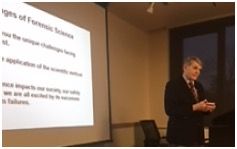Unique Challenges of Forensic Science Highlighted at Local SAS Meeting
The March meeting of the New York–New Jersey Chapter of the Society for Applied Spectroscopy (NYSAS) was held on March 28 in the Ceramics Research building at Rutgers University. The invited speaker was Professor John A. Reffner of John Jay College of Criminal Justice in New York, New York.
The March meeting of the New York–New Jersey Chapter of the Society for Applied Spectroscopy (NYSAS) was held on March 28 in the Ceramics Research building at Rutgers University. The invited speaker was Professor John A. Reffner of John Jay College of Criminal Justice in New York, New York. The meeting was hosted by Professor Laura Fabris of the Department of Materials Science and Engineering at Rutgers.
Prof. John A. Reffner of John Jay College presenting at the March 2018 meeting of the New York–New Jersey Chapter of the Society for Applied Spectroscopy. The meeting was hosted at Rutgers University by Professor Laura Fabris.

Reffner’s scientific interests are focused on uniting microscopy with spectroscopy and applying novel technologies for advancing both materials and forensic science. He pioneered the development of infrared (IR) microspectrometers and innovative applications of IR microprobe technology for forensic applications. Among Reffner’s scientific accomplishments, he has received many prestigious scientific awards including the American Society of Trace Evidence Examiners’ Edmond Locard Award (2016), The Society of Applied Spectroscopy’s Gold Medal Award (2015), and the American Academy of Forensic Sciences’ Paul L. Kirk Award (2004). Reffner has also served as a consultant to the Connecticut State Police for over 25 years, and has testified as an expert witness in criminal, civil and patent litigations.
Reffners’s presentation focused on how combinations of analytical techniques are being used in forensic investigations. Today, Reffner noted, forensic science is under attack by defense attorneys, judges, and public advocates. Police departments, government agencies, and social groups are challenging the validity of the testimonies of expert witnesses. Some academics and scientists also question the way in which forensic laboratories analyze evidence and interpret the results of their studies. As a result, demands on forensic scientists are increasing daily.
In this context, there has been a call to standardize analytical methods used in the crime laboratories and spectroscopy has become an essential technology for elevating the quality of forensic evidence analysis. Reffner’s presentation included highlights of many interesting forensic cases that he has been involved in, including authenticating a winning lottery ticket, matching red fibers in a murder investigation, identifying the chemical makeup of a multilayer paint chip being used as evidence in a hit and run case, and identification of adhesive residue found on a suspect’s knife.
The meeting was attended by many students and several university professors, as well as by consultants and industrial members. The students were encouraged to ask questions and received an engraved pen for participation in the question-and-answer session following the talk.
During the dinner section of the meeting, several students from Fabris’s group displayed posters. The posters highlighted optimization and applications of surface-enhanced Raman spectroscopy (SERS) and facilitated interesting discussions between the students and industrial attendees.
More information about the chapter and the schedule of meetings can be found at www.nysas.org.
Prof. John A. Reffner of John Jay College reviews a student poster at the NYSAS March 2018 meeting.

Debbie Peru is the secretary of the New York–New Jersey Chapter of the Society for Applied Spectroscopy (NYSAS).
Researchers Develop Adaptive Gap-Tunable SERS Device
April 24th 2024In a new study, researchers from Ulsan National Institute of Science and Technology and Pohang University of Science and Technology presented a new surface-enhanced Raman spectroscopy (SERS) device, improving gap plasmon resonance.
Getting accurate IR spectra on monolayer of molecules
April 18th 2024Creating uniform and repeatable monolayers is incredibly important for both scientific pursuits as well as the manufacturing of products in semiconductor, biotechnology, and. other industries. However, measuring monolayers and functionalized surfaces directly is. difficult, and many rely on a variety of characterization techniques that when used together can provide some degree of confidence. By combining non-contact atomic force microscopy (AFM) and IR spectroscopy, IR PiFM provides sensitive and accurate analysis of sub-monolayer of molecules without the concern of tip-sample cross contamination. Dr. Sung Park, Molecular Vista, joined Spectroscopy to provide insights on how IR PiFM can acquire IR signature of monolayer films due to its unique implementation.
The World of Microplastics Up to Date – an Overview
April 23rd 2024Watch this 20-minute educational video by Andreas Kerstan, Agilent Product Specialist in molecular spectroscopy, to gain a comprehensive update on the microplastics landscape and the environmental concerns related to them. Discover the current challenges in microplastics characterization and how Agilent innovative solutions and techniques, including FTIR, LDIR, GC/MS, and ICP-MS, are addressing these issues head-on.